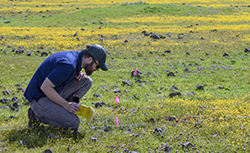California hosts approximately 6,500 different kinds of plants that occur naturally in the state, and many of these are found nowhere else in the world. Some of these plants are so rare or have been so impacted by human influence that they are at risk of permanent extinction from the wild and have been protected by state and federal laws. The California Department of Fish and Wildlife’s (CDFW) Native Plant Program is developing and implementing standardized and repeatable monitoring plans for ten state and federally listed plant species on nine CDFW Ecological Reserves throughout the state. This work is funded by a federal grant awarded in 2015.

One of the plants being monitored is Butte County meadowfoam (Limnanthes floccosa ssp. californica), which occurs at North Table Mountain Ecological Reserve, north of Oroville in Butte County. The reserve is on an elevated basalt mesa that was created by ancient lava flows and supports a rare type of vernal pool called Northern Basalt Flow Vernal Pools. There were only 498 Butte County meadowfoam plants found on the reserve this spring. The reserve also supports a high diversity of other plant species that erupt with bright colors in the spring and attract hordes of visitors.
Another plant being monitored is the endangered Slender-petaled thelypodium (Thelypodium stenopetalum) that occurs at Baldwin Lake Ecological Reserve, in the San Bernardino Mountains near Big Bear. The reserve is in a unique environment known as the pebble plains, which only occur in Big Bear Valley and nearby Holcomb Valley. The pebble plains were formed when glaciers receded during the Pleistocene age and mainly consist of clay soils overlain by a layer of orange and white quartzite pebbles. Slender-petaled thelypodium only grows in this rare pebble plain habitat, and only 15 plants were found on the reserve last spring. Other rare plant species such as the endangered bird-foot checkerbloom (Sidalcea pedata) are found on the reserve and in the surrounding pebble plain habitat.
The monitoring project also includes plants at Little Red Mountain, Boggs Lake, Loch Lomond, Stone Ridge, Phoenix Field, Pine Hill and Apricum Hill Ecological Reserves. The grant is funded through January 2018 and the Native Plant Program has applied for another grant to continue this project.